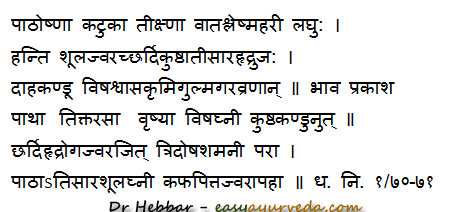Patha – Rajapata – Dose, Medicinal qualities, Benefits, Ayurveda Details
Patha – Cissampelos pareira is an Ayurveda herb, used mainly in the treatment of fever, intestinal worms, non healing wounds etc.
Another herb – Cyclea peltata is also used in the name of Patha.
Botanical name – Cissampelos pareira
Family – Menispermaceae (Guduchi kula)
Table of Contents
Classification
Classification of Cyclea peltata
Kingdom – Plantae
Division – Spermatophyta
Sub-division – Angiospermae
Class – Dicotyledonae
Order – Ranales
Family – Menispermaceae
Genus – Cyclea
Species – Peltata
Vernacular names
Names in different languages:
Hindi name – Padhi, Padha
Kannada name – Padavali
Telugu name – Chiruboddi
Malayalam – Patathali, Kattuvalli
Gujarati name – Venivel
Bengali name – Akanadi
Marathi name – Padavela
Historical review, Sanskrit synonyms
Patha was found by Garuda and Shukara. This drug has been used by Indra to kill Asuras. In Vedic literature, Patha was described as Pata. Synonyms used at those times were Uttanaparna, Devajuta, Sahamaanasaheeyas etc. Vedic texts have quoted it as Viryavathi, Vishagni, Rakshogni, Medya, Kamya and Garbha Sthapana. Rig Veda has delineated this as Sapthaneebhadana and Vaseekarana. In Atharvaveda it was used for increasing IQ and conquering the opponent in debates.
Sanskrit Synonyms:
Ambashta – It will act as sthambaka
Varatikta (bitter in taste)
Pracheena – Plant is seen in eastern part of India
Papachelika – Cure many disease
Aviddha karni – Patha has peltate leaves
Rakashtila – Fruit of patha will have one seed
Ekasthila, Kuchelika
Classical categorization
Seers have categorized Patha into the following group of herbs.
Charaka –
Sandhaneeya – which has joining nature, useful in wounds and fractures.
Jwarahara – Useful in treatment of fever
Stnayashodhana – Cleansing breast milk
Sushruta –
Mustadi, Aragvadhadi, Pippalyadi. Ambashtadi, Brihatyadi, Patoladi
Vagbhata – Mustadi, Aragvadhadi, Ambashtadi, Patoladi, Vatsakadi.
According to Nighantus,
Sousruthanighantu :- Vidangadi gana
Ashtanganighantu :- Pippalyadi gana
Dhanwantarinighantu :- Guduchydi varga
Shodalanighantu :- Guduchydi varga
Shadrasanighantu :- Madanadi varga
Hridayadeepikanighantu :- Doshagna varga
Rajanighantu :- Pippalyadi varga
Kaiyyadevanighantu :- Aushadi varga
Bhavaprakashanighantu :- Guduchyadi varga
Shaligrama Nighantu :- Guduchydi varga
Nighantuadarsha :- Guduchydi varga
Priya Nighantu :- Pippalyadi varga
Ayurvedic varieties, Properties
Ayurveda explains 2 types of Paata
1. Raaja paata (Cyclea peltata)
2. Laghu paata (Cissampelos pariera)
Cissampelos pariera is considered to be the main source of Paata in Northern India & in south Cyclea peltata is the source of Patha.
Also Stephania hernandrifolia / Stephania glabra are considered the source of Patha in different regions
Cissampelos pareira Medicinal properties
Taste: Tikta – Bitter
Guna (Qualities): Laghu – light to digest, Teekshna – piercing, enters deep into the tissues.
Vipaka – taste conversion after digestion – Katu (pungent)
Veerya (Potency) – Hot
Effect on Tridosha – Balances Pitta and Kapha
Pharmacological action – Hypoglycemic, Muscle relaxant, CNS depressant, Anti tumor activity
Chemical constituents
Cissampelos pareira – Hayatin, Hayatinin, Menismine, Cissamine, Pareirine, Cycleanine, Bebeerine, quercitol
Cyclea peltata- Perpamine, Cycleamine, Chondocurine, Magnoflorine, etc.
Sanskrit verses

Functions, Part used, Dosage
Functions:
Vrushya – acts as an aphrodisiac.
Vishaghni, Vishahara, – detoxifies
Kushta, Kandunut – relieves skin diseases with itching as a symptom.
Chardijit – relieves vomiting
Hrudroga – relieves heart diseases
Jwara – relieves fever
Tridoshashamani – balances Tridosha, especially Vata and Kapha
Atisara – relieves diarrhea
Shulaghni – relieves abdominal colic pain
Kaphapitta jwara – Relieves fever due to imbalance of Kapha and Pitta. (which involves heaviness and burning sensation symptoms)
Krumi – Relieves intestinal worms
Gulma – relieves abdominal mass / bloating
Gara – relieves chronic toxicity
Vrana – brings about wound healing.
Part used: Root and stem
Dose: Churna (powder) – 1 – 3 grams per day
Kashaya – Decoction – 15 – 60 ml per day, in divided doses
Research, side-effects
Research:
Screening of antimicrobial activity of Cissampelos pareira
Anti-fertility activity of Cissampelos pareira
Diuretic activity of Cyclea peltata
Side effects:
Because Cissampelos pareira is used as female contraceptive in rural areas, it is not suitable for long term usage in women seeking infertility treatment. However, it can be administered for a short period of time.
It can be given in lower doses during lactation and in children. Seek medical advice for its usage during pregnancy.
Interaction with medicines, supplements
Can this be used while taking Homeopathic medicine?
Yes. This product does not react with homeopathic medicine.
Can this medicine be continued while taking supplements like multivitamin tablets, Omega 3 fatty acids etc?
Yes. Generally, this product goes well with most dietary supplements. However, if you are taking more than one product per day, please consult your doctor for an opinion.
With western
medicines
Seek your
doctor’s advice if you are taking this product along with other western
(allopathic / modern) medicines. Some Ayurvedic herbs can interact with modern
medicine.
If both Ayurvedic and allopathic medicines are advised together, then it is
best to take Allopathic medicine first, wait for 30 minutes and then take the
Ayurvedic medicine.
Ayurveda medicines
Important formulations:
Pushyanug Churna – used in the Ayurveda treatment of Menorrhagia, Metrorrhagia, Leucorrhoea, Menstrual disorder etc
Shaddharana Tablet – used in treating Vata diseases related to muscles, joints and nerves.
Useerasav – used in treating bleeding disorders, skin diseases, piles
Chandanasavam – used in the treatment of spermatorrhoea. It is also used to improve strength.
Ayurveda medicines containing Paata as mentioned in Charaka Samhita
Sthanya shodhana mahakashaya – used to cleanse and detoxify breast milk – Sutrasthana 4/18
Jwarahara mahakashaya – used in fever – Sutrasthana 4/39
Vyoshadya saktu – used in Prameha (diabetes), Kushta (skin disorders), Arsha (piles), Kamala – Sutrasthana 23/19-25
Pathadi kwatha – Used to detoxify breast milk – Shareera sthana 8/56
Vatsakadi kwatha – Used in fever – Chikitsathana 3/204-205
Lodhrasava – Pittaja prameha, kilasa, Pandu – Chikitsa sthana 6/41-44
Mahatikta ghrita – Kushta, Kamala – Chi.7/144-148
Mahapanchagavya ghrita – Kamala, Udara roga, Halimaka – Chi.10/18-24
Phalarishta – Kamala, Pleeha vridhi, Grahani – Chi.14/148-152
Panchamakshara – Pleeha roga, Mutra ghatha, Atisara – Chi.15/189-192
Vyoshadya ghrita – Kamala, Udara roga, Pandu – Chi.16/119
Trushadya ghrita – Kamala, Pleeha – Chi.18/39-42
Panchmooladi basti – Pandu, Alasaka – Siddhistana a – 3/59-60
Ayurveda medicines containing Paata as mentioned in Sushruta Samhita
Aragvadadhi gana – Prameha, Kushta, Kandu – Sutrasthana 38/6
Musthadi gana – Sthanya shodhaka, Yoni vikara – Su.38/54
Hingvadi churna – Pleeha, Udara – Chi.5/28
Mahatikta ghrita – Kandu, Rakta pitta – Chi.9/8
Priyangvadi churna – Prameha – Chi.11/10-61
Patha chitrakadi churna (leha) – Prameha pidaka – Chi.12/9
Bhadradi asthapana – Kamala, Prameha – Chi.38/60
Dvipanchamoola ghritam – Udara roga, Prameha – Ut.41/47
Pathadi churnam – Pleeha, Grahani – Ut.42/50
Ayurveda medicines containing Paata as mentioned in Ashanga Hrudaya
Vidangadi ghrita – Jeerna Jwara – Chi.1/93
Madhukadi ghrita – Pandu, Arsha – Chi 8/130-133
Rodrasava – Prameha, Pandu – Chi.11/26
Higvadi churna – Pleeha, Pandu – Chi.14/31-33
Mahavajraka ghrita – Kushta, Pleeha – Chi.19/19-20
Nimbadi ghrita – Pandu, Prameha – Chi.21/57-61
Ayurveda medicines containing Paata as mentioned in Sharangdhara Samhita
Pippalyadi churna – Grahani – S.S.M.6/65
Hingwadi churna – Yakrit vikara – S.S.M.6/121
Kutaja avaleha – Kamala, Pandu, Udara roga – S.S.M.8/38-44
Ayurveda medicines containing Patha as mentioned in Bhaishajya Ratnavali
Jwaranagara mayura churnam – Jwara, Kamala, Pandu – B.R.5/467- 478
Madhyama gangadhara churna – Udara, Grahani – B.R.8/46- 49
Lavangadhya churna – Kamala, Haleemaka, Pandu – B.R.8/76- 82
Jeerakadhya churna – Kamala, Pandu – B.R.8/108-112
Yakridariloham – Yakrit vridhi, Gulma – B.R.41/132-135
Therapeutic uses
Therapeutic uses of Cissampelos pareira – Patha
Fever
Decoction of Patha, Ushira and Balaka acts as digestive in fever. So is the decoction of Shunti, Balaka, Yavasa separately with Parpata.(V.D1-8)
Juice of Patha root is taken in the morning for 3 days checks fever with rigor and and so does Lashuna.(V.D1-8)
Diarrhea
The dried vegetable of Lonika and Patha cooked with curd and Pomegranate and added with profuse fat should be given in food.(C.S.Chi 19-33)
Ankhota root and similarly Patha leaf with Buffalos buttermilk checks diarrhea. (B.A Atisara 171)
Patha or Mangos bark pounded with cows curd alleviates the disorder and burning sensation of Diarrhea immediately(B.P.Chi.2-42)
Piles
Patha combined with any one of Dhuralabha, Yavani, Bilva, or Shunti destroys piles.(C.S.Chi.14-100)
Edema
Liquid gruel cooked with Patha and Panchakola has the same properties i.e. it is useful in edema, diarrhea, heart disease, gulma, piles, slow digestion & prameha. (A.H.Chi 17-21)
Prameha
For Lavanameha Decoction of Patha and Aguru is the specific remedy.(S.S.Chi.11-5)
In Sarpirmeha one should take the powder of Patha, Kutaja, Hingu, Katuka, Kushta with Guduchi and Chitraka.(V.M35-12)
Internal Abscess
Patha root mixed with honey and taken in Rice water cures internal Abscess immediately (V.M43-15)
Wound
In wounds caused by Kapha, Leaves of Patha, Moorva, Guduchi, Kakamachi, Haridra, Shukanabha should be used for covering. (S.S.Chi1-115)
For easy delivery
Applying the paste of Patha, Tulasi, Vasa, Apamarga and Kutaja separately on umbilicus, pelvis and vulva of the women helps in easy delivery.(V.M65-12)
As galacto depurant
Patha comes first in the Galacto depurant group.(K.s.P-7)
Hemicrania
Hemicrania is relieved by taking Patha leaf as the snuff.(G.N3-2-6)
Splenomegaly
Intake of root of White Punarnava or Patha or Guduchi pounded with rice water destroys splenomegaly. (R.M7-5)
Sthanika Karma (Systemic Action)
External Application – Anti poisonous, wound healing properties and indicated in skin diseases. Indicated in Non healing wounds, Sinuses etc. In migraine Its root juice or powder can be used for nasya.
Internal administration-
Digestive system – Indicated in Indigestion, Abdominal colic, Diarrhea, loss of digestive power etc. It has Carminative, Digestive, Absorbent and Anthelmintic properties.
Circulatory System – Act as a blood purifies and relieves edema and other blood borne disorders.
Respiratory system – Pacifies kapha dosha. indicated in cough, breathing disorders
Reproductive system – Purifies breast milk (Stanya sodhana)
Excretory system – It is indicated in Dysuria, UTI etc. Helps to increase urine output
Tapakrama – Reduces burning sensation, indicated in fever (Sita jvara and jvaratisara)
Tvak – Indicated in skin disorders
Satmikarana – Ant poisonous and promotes body strength










